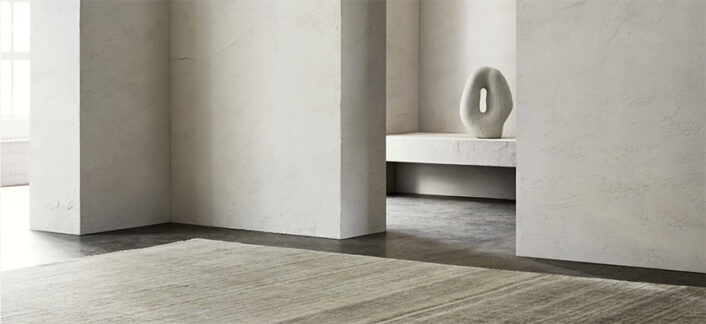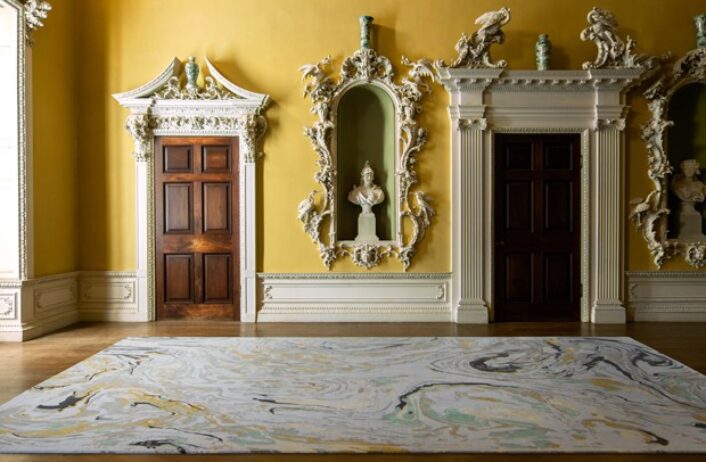Design
Nodus leads way in artist + rug collaborations
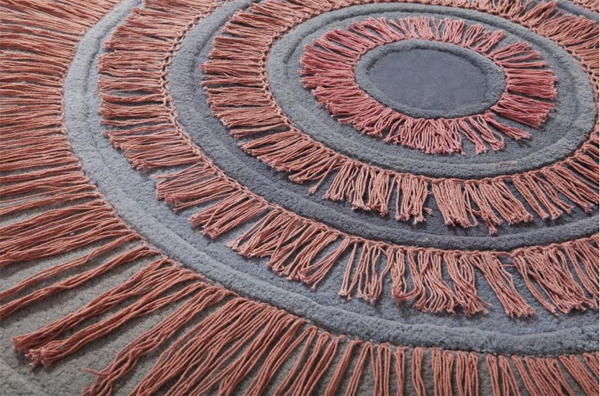
The hand-tufted “Jupon” was designed by Sam Baron, Fabrica’s artistic director. The French designer has worked in furniture design, graphic design, and exhibition spaces so this was nothing new for him. In French, the word japon refers to “a garment used under a skirt or dress in order to create volume.” Baron says that he designed this rug with the energetic rippling costumes of can-can dancers in mind. The rug is made from wool and produced in India.
Image courtesy of: Deco Soup
Nodus is a company based in Italy’s Lombardy area; they produce exclusive rugs designed by various artists from around the world. The company’s philosophy behind the handmade collection is best described by using Francois-Henri Pinault’s quote (as courtesy of the company’s website), “Luxury is the meeting between a vision of the future which surprises and a comprehension of the past which reassures.”
The team at Nodus falls back on this quote in explaining how they create such an eclectic collection. The designs will unexpectedly surprise and delight those who choose to display the rugs in their personal sanctuaries.
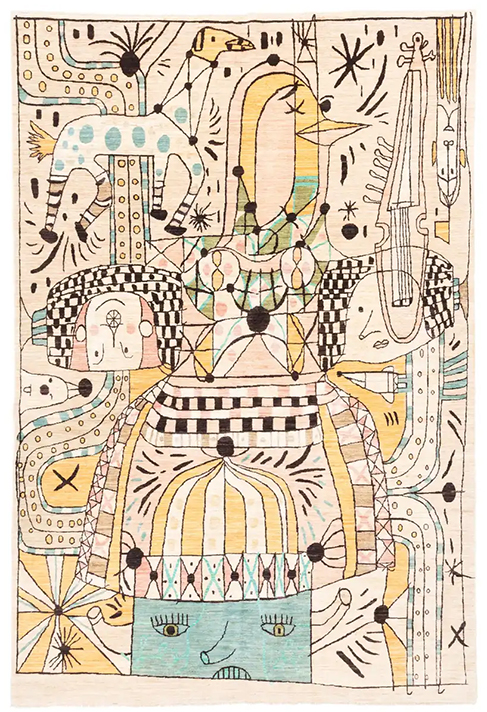
Afgan Folklore Rug by Jamie Hayon, hand-knotted in wool. In creating this rug, Hayon replicated the special weaving techniques of Afghan artists; sharp detail is noted in every single thread. Courtesy of 1st Dibs, “Inspired by the vibrant life of afghan culture, I incorporated into the design certain elements such as beautiful dresses with traditional patterns and a symphony of instruments and paired them together with my own whimsical style. The afghan artisans use a very special technique of tapestry which brings the design to life with sharp detail down to the last thread.”
Image courtesy of: 1st Dibs
For the artists that Nodus commissions, rugs are canvases for graphic design, artwork, illustrations, and photographic prints. Under the company’s umbrella are some of the world’s best craftsmen who combine ancient weaving and textile art techniques with the contemporary vision of top designers and architects. Mixing the traditional and the contemporary produces the most innovative products.
Every rug from Nodus is made with concern for human rights, the right to good working conditions, and fair compensation. As child labor has previously been a horrific byproduct in the industry, each manufacturing place is inspected every three months.
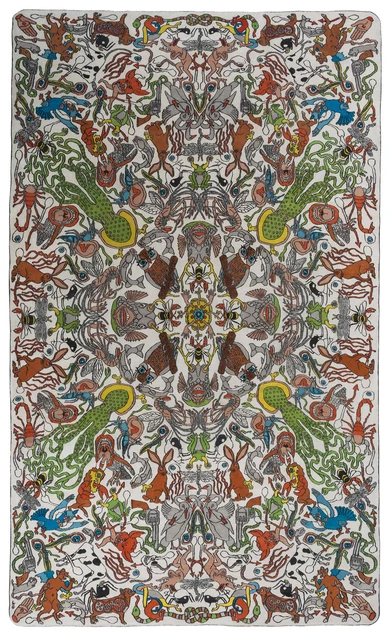
“Underworld” was designed by the Belgian design house Studio Job. From afar, the design looks cheerful and comic-like; however upon closer examination, the characters are all “out of their normal context.” The breathing people and animals are manipulated… freaks-of-nature.
The rug was made in Nepal and features 250 knots per-square-inch and it comes from a limited edition of only ten.
Image courtesy of: Jane Richards Interiors
Makers in six countries produce Nodus’ rugs. Visiting each manufacturer one by one ensures that hand-weaving remains at the forefront of each finished product. Nodus’ collection of sixty rugs are made in Nepal, Pakistan, India, Turkmenistan, China, and Turkey.
The rugs are all unique in that they are organically-shaped with irregular profiles. Inspiration for the designs comes from near and far… maps, books, and tablecloths are all a sources of creativity that the artists refer to. Among some of the artists that Nodus has commissioned, these are some of our favorites: Sebastian Jansson, Ron Gilad, Bartoli Design, Studio Job, and Samuele Mazza.
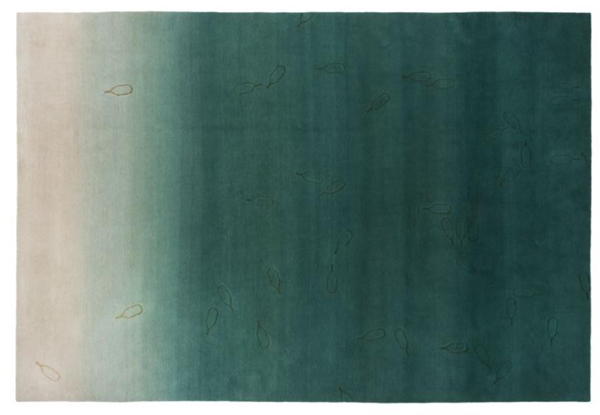
“Color Flow” was designed by Florian Hauswirth and made in Nepal. The Swiss designer’s carpet resembles the gradient color of blue and sky… it is calming and uplighting.
Image courtesy of: Deco Soup
A rug’s thread thickness depends on the area in which it was woven. Clearly, thickness influences the work’s design; it also affects the rug’s compactness. Very thin threads allow for creating a dense structure which ensures a more solid carpet with an elaborate design full of small details. Usually, wool rugs are produced from sheep wool; however goat and camel wool can also be used.
Luxury carpets use either traditionally-dyed fibers or synthetic-dyed fibers; the main difference between these two solutions is the duration of the color and the brightness. The luxury carpets made with undyed wool are able to take advantage of the colors found in nature. Matteo Ragni, one of the designer Nodus commissioned said about the role of textiles in design, “Every material or technique is interesting for the potential it expresses. The world of textiles offers many interesting applications.”
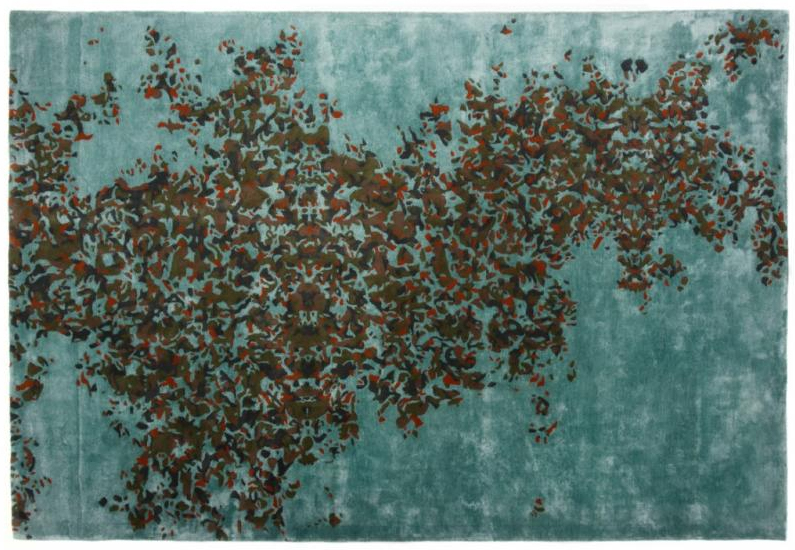
“Camouflage Micro,” by Alberto Artesani. Hand-tufted to 10 mm. and made in India.
Image courtesy of Nodus
As to why Nodus produced their rugs at far-reaching locations, Andrea Galimberi explains that “real luxury rugs” are handmade; he adds that unfortunately Europe does not have the tradition of making them. Thus, rather than the machine-made carpet production by other companies, the hand-made or even hand-knotted pieces are produced in a place seeped in tradition.
A “laboratory of experimentation” is how Nodus refers to itself. Set on innovation yet oozing in tradition… we are sure that this laboratory will stay very busy for the foreseeable future!
